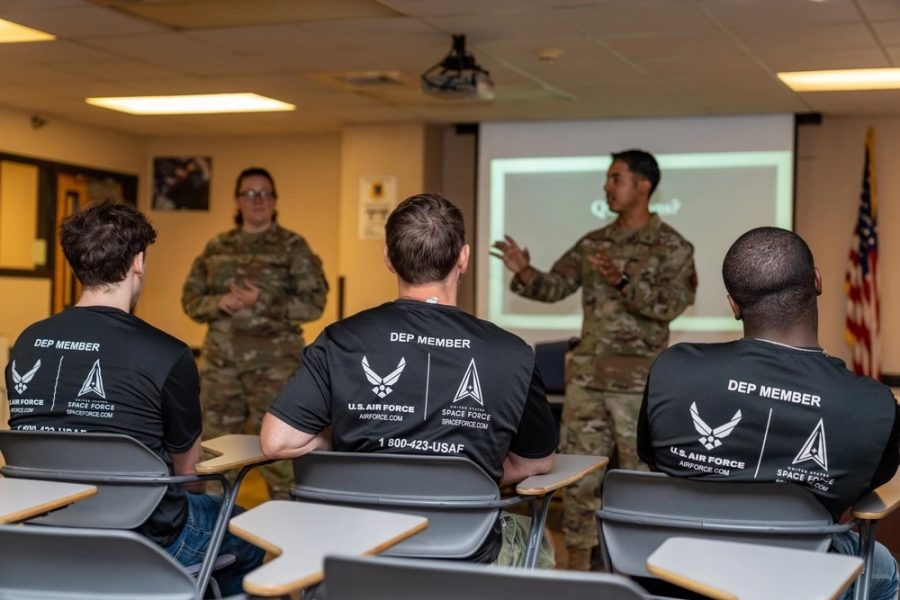NATIONAL HARBOR, Md.—A year after the Air Force fell 10 percent short of its recruiting goals, the service will hit its fiscal 2024 goal and aim even higher for a 16 percent larger pool in 2025. The branch’s top recruiter, Brig. Gen. Christopher Amrhein, said a plus-up of 370 recruiting staff will help put that target in reach.
In 2025, the Air Force Recruiting Service is shooting for:
- 32,500 recruits for the Active-Duty Air Force
- 7,600 for the Air Force Reserve
- 8,679 for the Air National Guard
- 800 for the Space Force
“It’s ambitious, but I believe it is executable,” Amrhein told reporters at AFA’s Air, Space & Cyber Conference. Though he did not say whether the 370 additional personnel would consist entirely of recruiters, the extra staff “is a sizable jump, and I think it definitely sets us in the best footing we can.”
The fiscal 2024 goal was 27,100 Active-Duty enlisted recruits. Achieving it marked a sharp comeback from fiscal 2023, where the Air Force missed its recruiting goals for the first time since 1999. That year’s goal was 26,877 new enlisted Airmen, which the Air Force missed by about 10 percent, though the Space Force exceeded its own goal of 472 Guardians.
Amrhein credited the bounceback to new incentives, process improvements, and an ongoing effort to broaden the pool of eligible candidates.
“There wasn’t one thing,” that made 2024 successful, the general said. “It was multiple levers being pulled in unison.”
Over the past few years, these levers have included allowing small hand and neck tattoos, aligning the Air Force body fat composition rules with Defense Department standards, and giving some qualified applicants a chance to retest if they test positive for marijuana use.
On the incentive side, the enlisted college loan repayment program, enlistment bonuses, and a quick-ship bonus have also helped, but one of the most successful incentives in fiscal 2024 was the accelerated naturalization program, which Amrhein estimated brought in about 1,400 recruits. It is not uncommon for a new class at Basic Military Training to have 30 or more citizens-to-be, he said.
In January, Amrhein also adjusted the Air Force’s legal permanent resident requirement from 10 years to two to align with the Defense Department allowances. AFRS is also looking to expand the number of job specialties open to U.S. citizens or establish a conditional delayed entry program (DEP) for recruits who are still working through the naturalization process.
Process Change
Changes to the recruiting and medical assessment processes helped too. One of the largest barriers to enlistment is the medical review process. The electronic health record system MHS-Genesis connects to most civilian health information exchange networks to give U.S. Military Entrance Processing Command access to an applicant’s medical history, but the history is often incomplete or insufficient, requiring extra documents, which slows down the process.
“About 8,800 people in 2023 walked away from the accessions process because the medical assessment was taking too long,” Amrhein said. “That’s talent we just can’t afford to have walk away.”
Last year, the Air Force hired 63 contractors to help move the process along, giving recruiters more time to focus on bringing in new talent. Amrhein said the contractors are meant to serve as a bridge solution while USMEPCOM works to bring down its processing times.
AFRS has also changed how it recruits, including a new “deliberate focus” on training and adjusting goal timelines from quarterly to monthly, which shows trends earlier, the general said.
The plus-up of 370 recruiting staff should help as well. Guided by studies conducted by the RAND Corporation and Air Education and Training Command, AFRS plans to place many of the new recruiters across the U.S. “southern smile” which stretches from California to the southeast coast. Others will work from military bases across Europe and the Pacific to attract the dependents of current service members or other citizens living abroad.
AFRS is also testing out agile recruiter cells, where two or three recruiters at a squadron headquarters can help colleagues farther away who need help handling new leads.
“If we need to surge support into a certain region, then we have the ability to flex those within that squadron’s area of responsibility, rather than have them permanently placed in some areas,” Amrhein explained.
Finding volunteers to fill those recruiting slots usually has not been a challenge, said AFRS senior enlisted leader Chief Master Sgt. Rebecca Arbona, and all 370 of the new slots are either filled or currently in the AFRS schoolhouse. It helps that the service reopened the recruiter duty back up to Senior Airmen, rather than limiting it to noncommissioned officers.
“Opening that up lets us grow them a little earlier and we’ll probably have them for a longer duration of time as well,” she said.
Recruiting is still a challenge, Amrhein warned. Competition with private industry is fierce, public awareness of service is low, and even with the 370 plus-up, AFRS still has the smallest recruiting footprint in the military. But the recent changes and partnerships with agencies such as Civil Air Patrol and the Air & Space Forces Association should help, he said.
“We cannot take our hand off the throttle,” Amrhein said.
